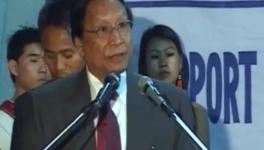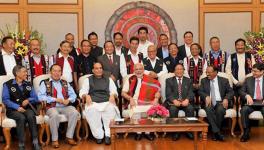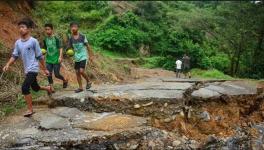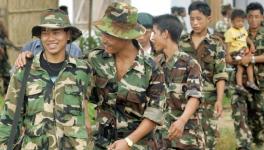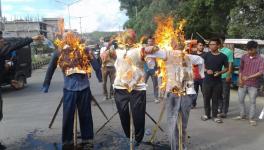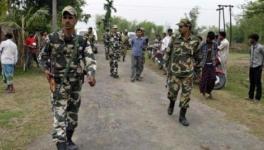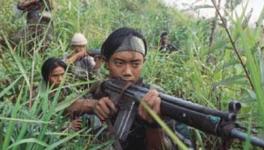Naga-Kuki Conflict: Why Has a Three-day Mourning Shaken The NSCN(IM)?
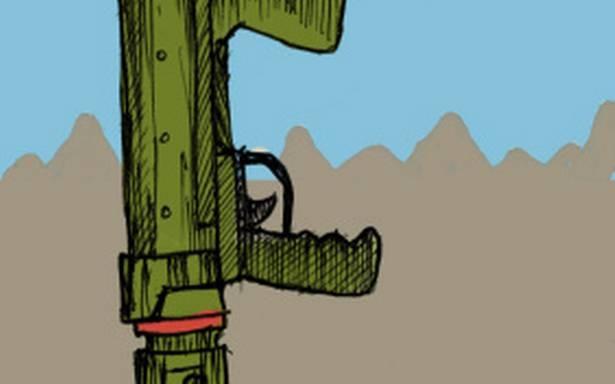
Image Used for Representational Purpose Only
The National Socialist Council of Nagaland (Isaak Muivah) (NSCN(IM)) accused the Kukis of starting the Naga-Kuki conflict of the 1990s yesterday. The NSCN(IM)’s statement came after Kuki groups including the Kuki Inpi Manipur (KIM) and Kuki National Organisation (KNO) observed Sahnit-Nior the Kuki’s Black Day on Thursday. The Kuki groups in Manipur have observed Sahnit-Nifor over 20 years, as it is claimed to be a Kuki tradition that until justice is done, the mourning cannot stop.
Sahnit-Ni refers to a massacre that took place during the Naga-Kuki conflict which began in 1992, and continued sporadically till 1997. On September 13, 1993, the Naga Lim Guards (NLG) a proxy for the NSCN(IM) killed over a hundred Kuki villagers in a single day. The bloodbath has been referred to by the Kuki groups as ethnic cleansing. This year, the Kuki groups observed a three-day event starting from September 11. The KNO leader, PS Haokip while blaming the NSCN(IM) for the clashes, demanded justice for the Kuki victims before the final Indo-Naga peace agreement is inked. He even threatened to pull out of the peace talks his organisation is currently engaged in with the government of India.
The NSCN(IM) has denied any involvement in the massacre or the five-year conflict, instead they have claimed that the Kukis started the conflict which prompted the Naga people to form the NLG. The NSCN(IM) also claimed that the Kukis at the time were attempting to capture Moreh town and that the NLG was created to prevent this, and to protect the Naga people. Moreh town is the main border trading town between Manipur and Myanmar. According to the South Asia Terrorism Portal(SATP), the conflict around Moreh was not quite an ethnic conflict over land.
“A number of Kuki outfits like Kuki National Army (KNA), Kuki National Front (KNF) and many others had been struggling for a separate State within the Indian Union since the late eighties. The ethnic conflict had an added dimension as a result of a bitter struggle to control drug trafficking and smuggling of contraband through the border town of Moreh. The NSCN-IM controlled this illegal commerce till Kuki-Naga clashes erupted in 1992. The Kukis captured it from the Nagas, but the NSCN-IM remained determined to drive its rival out of Moreh, as well as out of Kuki settlements in the Naga dominated hill districts. The conflict had resulted in the death of nearly a thousand people and an enormous loss of property. Over 2,000 houses were burnt and hundreds of villages were affected.”
The NSCN(IM) also accused the Kuki groups of attempting to sabotage the Indo-Naga peace process. At present,the Kuki armed groups are under a Suspension of Operation (SoO) agreement with the Indian armed forces. The SoO has been in effect since August 2005. In August 2008, a tripartite agreement was signed between the United People’s Front (UPF) and the KNO, the government of Manipur and the government of India. The political dialogue between the Kuki armed groups and the government began in 2016.
The Kuki armed groups had been fighting for a separate state comprising of the Kuki areas in Manipur. At present, the armed groups have agreed to drop their statehood demand, and instead have advocated setting up a Territorial Council along the lines of the Bodoland Territorial Council (BTC) in Assam. The BTC provides the Bodo people with adequate administrative autonomy on legislative, executive and financial matters. One interesting note is that the Kuki armed groups have also requested a regional office of the Ministry of External Affairs to be set up within the Territorial Council to allow the Kuki people visa-less travel to and from Myanmar to meet their relatives. This arises as the boundary between the two countries did not take into account the social conditions under which the lines were arbitrarily drawn on a map. The proposed Territorial Council would also control an educational board for secondary and higher secondary education as well as have one member in each house of parliament.
Also Read: Nothing to Show: Three Years of the Framework Agreement
The Indo-Naga peace process is still shrouded in mystery. The contents of the Framework Agreement are unknown. However, from sporadic media reports and press statements, it appears that the NSCN(IM) has abandoned its demands of ‘sovereignty’ as well as ‘territorial integration’. This, of course, leaves one wondering what the purpose of restarting the Indo-Naga conflict after the Shillong Accord was. However, three years after the Framework Agreement was signed, there is nothing to show, neither on the side of the NSCN(IM), nor for the government of India. The periodic statements from the union and state government that appeared around the time of the Nagaland assembly elections seem to have died down. Further, the Khaplang faction, which is now led by Yung Aung after a bloodless coup, is not a party to the dialogue. Though it has been pointed out that the Khaplang faction now has established ‘Burmese Nagas’ in all the important administrative positions, one cannot discount the group’s capacity to derail the process under the United National Liberation Front of Western South East Asia (UNLFW).
Also Read: What the NSCN(K) Coup Could Mean
Therefore, the NSCN(IM) is already on the political backfoot. The three-day observance of the Naga-Kuki conflict, complete with laying memorial stones, as well as placing the blame on the NSCN(IM) rather than the Naga people has heightened the NSCN(IM)’s precarious position. Hence, the NSCN(IM)’s statements which blamed the Kukis for the conflict.
The question, however, is why did the Kuki groups choose to observe a three-day mouring this year? In 2016, civil society groups attempted to bury the hatchet between the Naga, Kuki and Meitei people in the face of a blockade. Other attempts at reconciliation have also been made periodically between the two sides to this conflict. However, the issue now boils down to territory and a peace deal. Several areas of Manipur have mixed populations with Naga and Kuki villages appearing in close proximity. Thus, when both parties to the conflict are negotiating independently of each other with the government of India for greater autonomy, a situation conducive for ethnic conflict is created.
Also Read: Indo-Naga Talks: The Difficult Road to Peace
On one hand, the reports on the Indo-Naga peace process indicate an extension of Article 371A to all the Naga inhabited areas. This has been opposed most vociferously in Manipur and by the Meitei people. Considering that the Kuki groups chose to demand justice for the Kuki victims of the ethnic conflict of the 1990s before a deal is signed, may indicate a fear that the areas they claim as a part of the envisioned Territorial Council could get incorporated in the ideological Nagalim. It would be in the NSCN(IM)’s interest to assuage the Kuki groups before signing any peace agreement with the government of India, else their retirement scheme may get disrupted.
Get the latest reports & analysis with people's perspective on Protests, movements & deep analytical videos, discussions of the current affairs in your Telegram app. Subscribe to NewsClick's Telegram channel & get Real-Time updates on stories, as they get published on our website.









